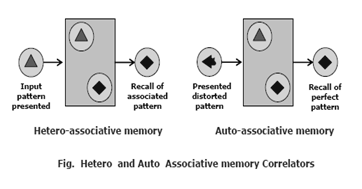Working Of Associative Memory
Introduction:-An associative memory is a storehouse of associated patterns which are encoded in some form. When the storehouse is triggered or excited with a pattern, then the associated pattern pair is recalled or appears at the output. The input could be an exact or distorted or partial representation of a stored pattern.
The associated pattern pairs

The association is represented by the symbol  .The associated pattern pairs are stored the memory.When the memory is triggered with an input pattern say Δ then the associated pattern Γ is retrieved automatically.
.The associated pattern pairs are stored the memory.When the memory is triggered with an input pattern say Δ then the associated pattern Γ is retrieved automatically.
Associative Memory - Classes
There are two classes of associative memory: auto-associative and hetero-associative memory.
An auto-associative memory, also known as auto-associative correlator, is used to retrieve a previously stored pattern that most closely resembles the current pattern;
A hetero-associative memory, also known as hetero-associative correlator, is used to retrieve pattern in general, different from the input pattern not only in content but possibly also different in type and format.

Encoding or Decoding:-Building an associative memory means, constructing a connectionweight matrix W such that when an input pattern is presented, andthe stored pattern associated with the input pattern is retrieved. This process of constructing the connection weight matrix is calledencoding.
After memorization, the process of retrieving a stored pattern, given an input pattern, is called decoding.
Errors and noise:-The input pattern may contain errors and noise, or may be anincomplete version of some previously encoded pattern. When a corrupted input pattern is presented, the network willretrieve the stored pattern that is closest to actual input pattern.The presence of noise or errors results only in a mere decreaserather than total degradation in the performance of the network. Thus, associative memories are robust and fault tolerant becauseof many processing elements performing highly parallel anddistributed computations.
Performance Measures
The memory capacity and content-addressability are the measures of associative memory performance for correct retrieval. These two performance measures are related to each other.
Memory capacity refers to the maximum number of associated pattern pairs that can be stored and correctly retrieved.
Content-addressability is the ability of the network to retrieve the correct stored pattern.
If input patterns are mutually orthogonal - perfect retrieval is possible. If the stored input patterns are not mutually orthogonal – non